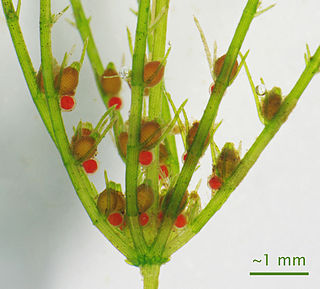
Electricity generation is the process of generating electric power from sources of primary energy. For utilities in the electric power industry, it is the stage prior to its delivery to end users or its storage.

In botany, a fruit is the seed-bearing structure in flowering plants that is formed from the ovary after flowering.

Flowering plants include multiple members of the clade Angiospermae, commonly called angiosperms. The term "angiosperm" is derived from the Greek words angeion and sperma ('seed'), and refers to those plants that produce their seeds enclosed within a fruit. They are the most diverse group of land plants with 64 orders, 416 families, approximately 13,000 known genera and 300,000 known species. Angiosperms were formerly called Magnoliophyta.

Sex is a trait that determines an individual's reproductive function, male or female, in animals and plants that propagate their species through sexual reproduction. The type of gametes produced by an organism define its sex. Commonly in plants and animals, male organisms produce smaller gametes while female organisms produce larger gametes. Organisms that produce both types of gametes are called hermaphrodites. During sexual reproduction, male and female gametes fuse to form zygotes that develop into offspring that inherit a selection of the traits of each parent.

A sex organ is any part of an animal or plant that is involved in sexual reproduction. The reproductive organs together constitute the reproductive system. In animals, the testis in the male, and the ovary in the female, are called the primary sex organs. All others are called secondary sex organs, divided between the external sex organs—the genitals or genitalia, visible at birth in both sexes—and the internal sex organs.

In biology, a spore is a unit of sexual or asexual reproduction that may be adapted for dispersal and for survival, often for extended periods of time, in unfavourable conditions. Spores form part of the life cycles of many plants, algae, fungi and protozoa.

In the fields of horticulture and botany, the term deciduous means "falling off at maturity" and "tending to fall off", in reference to trees and shrubs that seasonally shed leaves, usually in the autumn; to the shedding of petals, after flowering; and to the shedding of ripe fruit. The antonym of deciduous in the botanical sense is evergreen.

Tubers are enlarged structures used as storage organs for nutrients in some plants. They are used for the plant's perennation, to provide energy and nutrients for regrowth during the next growing season, and as a means of asexual reproduction. Stem tubers form thickened rhizomes or stolons ; well known species with stem tubers include the potato and yam. Some writers also treat modified lateral roots under the definition; these are found in sweet potatoes, cassava, and dahlias.

A power station, also referred to as a power plant and sometimes generating station or generating plant, is an industrial facility for the generation of electric power. Power stations are generally connected to an electrical grid.

Bryophytes are a proposed taxonomic division containing three groups of non-vascular land plants (embryophytes): the liverworts, hornworts and mosses. They are characteristically limited in size and prefer moist habitats although they can survive in drier environments. The bryophytes consist of about 20,000 plant species. Bryophytes produce enclosed reproductive structures, but they do not produce flowers or seeds. They reproduce sexually by spores and asexually by fragmentation or the production of gemmae. Though bryophytes were considered a paraphyletic group in recent years, almost all of the most recent phylogenetic evidence supports the monophyly of this group, as originally classified by Wilhelm Schimper in 1879. The term bryophyte comes from Ancient Greek βρύον (brúon) 'tree moss, liverwort', and φυτόν (phutón) 'plant'.

Plant reproductive morphology is the study of the physical form and structure of those parts of plants directly or indirectly concerned with sexual reproduction.

Alfred Malherbe was a French magistrate and amateur naturalist born in Mauritius to Pierre Marie François Malherbe and Rosalie Le Meusnier Molineuf. The family originally came from Metz. Alfred became the administrator of the Museum of Metz.

The garden strawberry is a widely grown hybrid species of the genus Fragaria, collectively known as the strawberries, which are cultivated worldwide for their fruit. The fruit is widely appreciated for its characteristic aroma, bright red color, juicy texture, and sweetness. It is consumed in large quantities, either fresh or in such prepared foods as jam, juice, pies, ice cream, milkshakes, and chocolates. Artificial strawberry flavorings and aromas are also widely used in products such as candy, soap, lip gloss, perfume, and many others.

A flower, sometimes known as a bloom or blossom, is the reproductive structure found in flowering plants. The biological function of a flower is to facilitate reproduction, usually by providing a mechanism for the union of sperm with eggs. Flowers may facilitate outcrossing resulting from cross-pollination or allow selfing when self-pollination occurs.

Aloinopsis is a genus of ice plants from South Africa.

In botany, succulent plants, also known as succulents, are plants with parts that are thickened, fleshy, and engorged, usually to retain water in arid climates or soil conditions. It is a characteristic that is not used scientifically for the definition of most families and genera of plants because it often can be used as an accurate characteristic only at the single species level. The word succulent comes from the Latin word sucus, meaning 'juice', or 'sap'. Succulent plants may store water in various structures, such as leaves and stems. The water content of some succulent organs can get up to 90–95%. Some definitions also include roots, thus geophytes that survive unfavorable periods by dying back to underground storage organs may be regarded as succulents. In horticultural use, the term succulent is sometimes used in a way that excludes plants that botanists would regard as succulents, such as cacti. Succulents are often grown as ornamental plants because of their striking and unusual appearance, as well as their ability to thrive with relatively minimal care.

Plants are predominantly photosynthetic eukaryotes of the kingdom Plantae. Historically, the plant kingdom encompassed all living things that were not animals, and included algae and fungi; however, all current definitions of Plantae exclude the fungi and some algae, as well as the prokaryotes. By one definition, plants form the clade Viridiplantae, a group that includes the flowering plants, conifers and other gymnosperms, ferns and their allies, hornworts, liverworts, mosses, and the green algae, but excludes the red and brown algae.

Sexual reproduction is a type of reproduction that involves a complex life cycle in which a gamete with a single set of chromosomes (haploid) combines with another to produce a zygote that develops into an organism composed of cells with two sets of chromosomes (diploid). Sexual reproduction is the most common life cycle in multicellular eukaryotes, such as animals, fungi and plants. Sexual reproduction does not occur in prokaryotes, but they have processes with similar effects such as bacterial conjugation, transformation and transduction, which may have been precursors to sexual reproduction in early eukaryotes.

Aloinopsis rosulata is a species of succulent plant, native to Southern Africa. It is a wintergrower, and produces a thick tuber. The flowers are pale pink with red stripes.

Aloinopsis schooneesii is a species of flowering plant in the genus Aloinopsis, in the ice plant family Aizoaceae, native to the eastern Cape Provinces of South Africa. It has gained the Royal Horticultural Society's Award of Garden Merit.



















